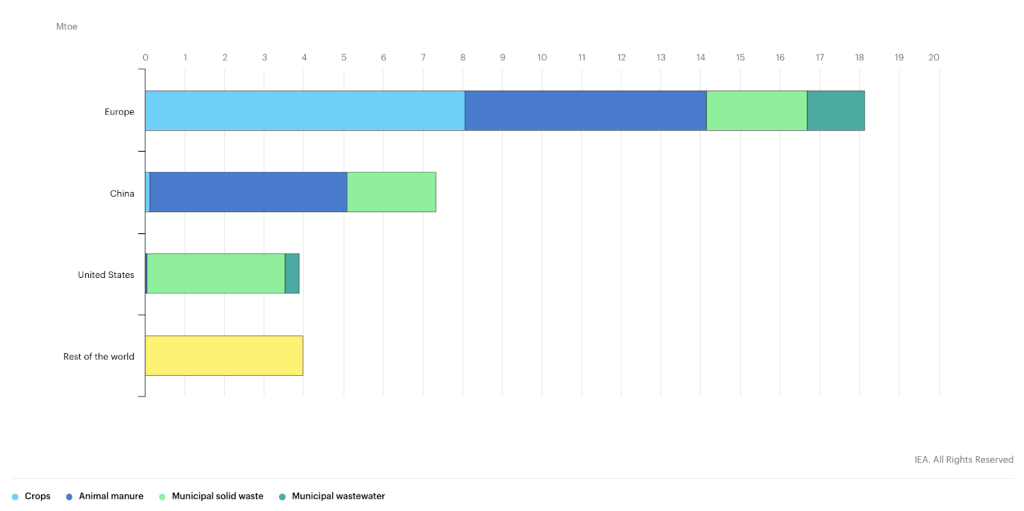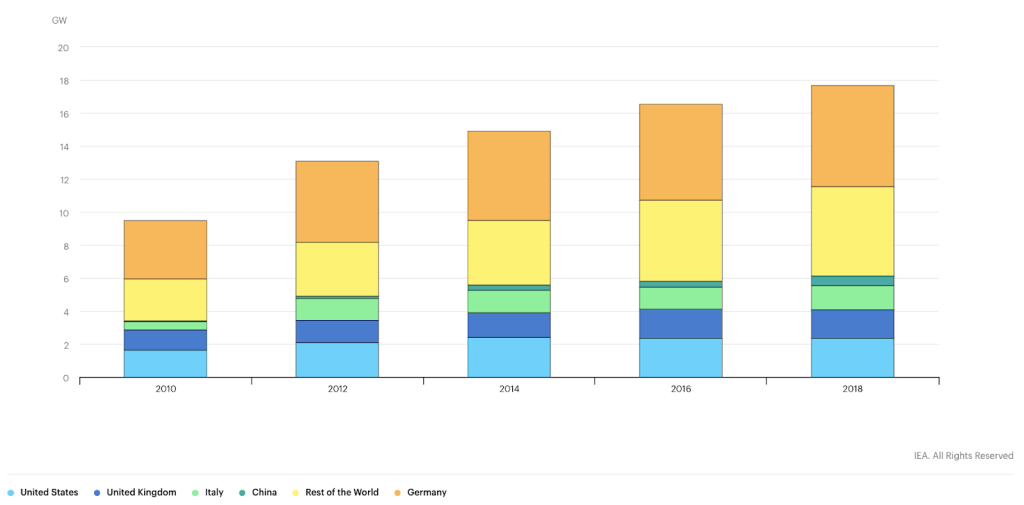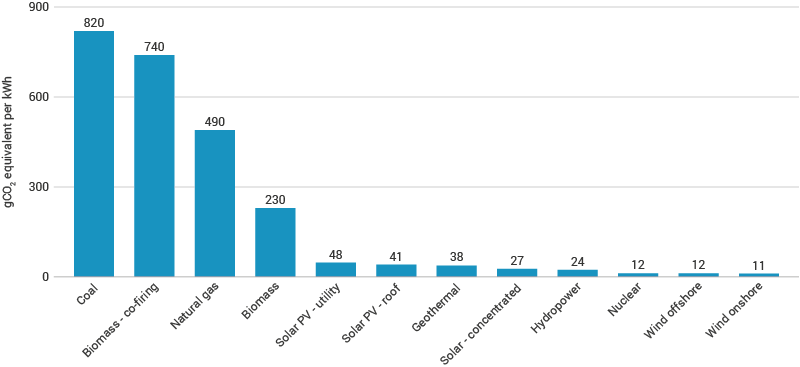Biogas Energy Explained: All You Need to Know
Impactful Ninja is reader-supported. When you buy through links on our site, we may earn an affiliate commission.
Learn more
Learn more
.
Hey fellow impactful ninja ? You may have noticed that Impactful Ninja is all about providing helpful information to make a positive impact on the world and society. And that we love to link back to where we found all the information for each of our posts. Most of these links are informational-based for you to check out their primary sources with one click. But some of these links are so-called "affiliate links" to products that we recommend. First and foremost, because we believe that they add value to you. For example, when we wrote a post about the environmental impact of long showers, we came across an EPA recommendation to use WaterSense showerheads. So we linked to where you can find them. Or, for many of our posts, we also link to our favorite books on that topic so that you can get a much more holistic overview than one single blog post could provide. And when there is an affiliate program for these products, we sign up for it. For example, as Amazon Associates, we earn from qualifying purchases. First, and most importantly, we still only recommend products that we believe add value for you. When you buy something through one of our affiliate links, we may earn a small commission - but at no additional costs to you. And when you buy something through a link that is not an affiliate link, we won’t receive any commission but we’ll still be happy to have helped you. When we find products that we believe add value to you and the seller has an affiliate program, we sign up for it. When you buy something through one of our affiliate links, we may earn a small commission (at no extra costs to you). And at this point in time, all money is reinvested in sharing the most helpful content with you. This includes all operating costs for running this site and the content creation itself. You may have noticed by the way Impactful Ninja is operated that money is not the driving factor behind it. It is a passion project of mine and I love to share helpful information with you to make a positive impact on the world and society. However, it's a project in that I invest a lot of time and also quite some money. Eventually, my dream is to one day turn this passion project into my full-time job and provide even more helpful information. But that's still a long time to go. Stay impactful,Affiliate Disclosure
Why do we add these product links?
What do these affiliate links mean for you?
What do these affiliate links mean for us?
What does this mean for me personally?
![]()
Biogas is a combustible gas that some say is more sustainable and has more greenhouse gas (GHG) reduction benefits than solid biomass, from which it is derived. So, we had to ask: What is biogas energy really, and how does it mitigate climate change?
Biogas energy is created via the combustion of flammable gas derived from biomass material. Per KWh produced, biogas emits between -81 and 251 grams of CO2 on a life-cycle basis. Biogas helps combat climate change and has various environmental benefits despite releasing some CO2 and GHG emissions.
Biogas energy makes up an ever-growing amount of total energy consumption. Keep reading to find out all about what biogas energy is, its global capacity, its carbon footprint, its environmental benefits and drawbacks, and how it can combat climate change.
The Big Picture of Biogas Energy
Biogas is a flammable gas derived from various biomass sources which can be combusted to produce electricity or can be further refined into fuel.
How Is Biogas Energy Defined
Biogas is an energy-rich form of biomass. Biomass is renewable organic material that comes from plants and animals. It is incredibly versatile and can be used to produce fuel, energy, and everyday products that contain plastics.
“Biomass: natural materials from living or recently dead plants, trees and animals, used as fuel and in industrial production, especially in the generation of electricity”
Oxford Dictionary
Biomass includes solid biomass for traditional use (cooking and heating), solid biomass for modern use (transportation), biofuels, and lastly biogas.
Biogas is a gaseous mixture of 45% to 75% methane (CH4), CO2, and small quantities of other gasses created through anaerobic digestion or thermochemical conversion of biomass in an oxygen-free environment.
“Biogas: a gas containing methane that can be burned as a fuel, produced by dead plants and animals as they decay”
Cambridge Dictionary
Biogas is either burned to create electricity or can be further purified down into renewable natural gas (i.e. biomethane) which can be used in place of conventional natural gas (NG).
In short, all biogas is inherently biomass, but not all biomass can be converted into biogas.
What Are the Different Types of Biogas Energy
Sources of biogas energy include:
- Crop residue
- Landfills
- Sewage and industrial wastewater treatment
- Animal waste
Generally, there are three technologies used to produce biogas from those sources:
- Biodigesters: Includes either wet or dry digestors. Wet digesters are the most common style of anaerobic digester. The substrates are moved around as liquid slurries, the consistency of the contents is 3-15% solids, and retention times range anywhere from 20-40 days. For dry digesters, the substrates are kept in a stackable form and remain in a pile during the anaerobic digestion process.
- Landfill gas recovery systems: The decomposition of municipal solid waste at landfill sites produces biogas which is ca[tured by pipes and extraction wells.
- Wastewater treatment plants: Organic matter, solids, nitrogen, and phosphorus can be recovered from sewage sludge and turned into an input material for producing biogas.
Biogas encompasses a diverse range of materials and technologies, so let’s have a closer look at it next.
| What biogas is | Biogas is a flammable gas composed mostly of CH4, CO2, and small quantities of other gasses created through anaerobic digestion or thermochemical conversion of biomass |
| What the different types of biogas energy are | Biodigestors, landfill gas recovery systems, and wastewater treatment plants are three pathways that can lead to the production of biogas. |
| How biogas energy works | Biogas energy works by combusting biogas in a biogas power plant to produce steam which turns a turbine and spins a generator to produce electricity. |
| The global capacity of biogas energy | The global biogas market has grown at an average annual rate of 9% over the last decade. Biogas has developed unevenly due to the uneven availability of materials and policies between countries |
| The carbon footprint of biogas energy | Biogas energy emits between -81 and 251 gCO2 per KWh, lower than that of solid biomass and potentially lower than all other fuel types. |
| The environmental benefits of biogas energy | Biogas can mitigate climate change, improve air quality, improve solid waste management and food security, reduce deforestation, promote energy independence, and create jobs. |
| The environmental drawbacks of biogas energy | Biogas emits CH4 when combusted, and CH4 is vastly more potent than CO2. |
| Biogas energy and climate change | Biogas can reduce global GHG emissions, thereby mitigating climate change, temperature rise, sea-level rise, ice melting, and ocean acidification. |
How Does Biogas Energy Work
In general, biogas energy works by combusting biogas in a biogas power plant to produce steam which turns a turbine and spins a generator to produce electricity.
How Does Biogas Energy Actually Produce Energy
The process of generating biogas energy begins with extracting the biomass, constructing the biogas power plant, and transporting the biomass to the power plant.
Sources of biomass energy that can be extracted include:
- Wood and wood processing wastes
- Agricultural crops and waste materials
- Municipal solid waste
- Animal manure
- Human sewage
The extracted biomass is then transported to biogas power plants by rail or truck, and conversion to biogas energy occurs via one of the following two processes:
- Thermochemical conversion: Gasification and pyrolysis, thermal decomposition processes where biomass is heated in a closed and pressurized vessel, are used to produce synthetic gas (syngas) or charcoal, bio-oil, renewable diesel, methane, and hydrogen, respectively. The two processes differ in the temperature and amount of oxygen in the reaction.
- Biological conversion: Fermentation is used to convert biomass into ethanol, and anaerobic digestion is used to produce renewable natural gas (biogas/biomethane).
What Is the Global Capacity of Biogas Energy
In 2019, 62.3 billion cubic meters (bcm) of biogas were produced globally. And of the 655 Terawatt hours (TWh) of electricity that were produced globally from biomass sources, biogas accounted for 15% (98 TWh) of total biopower production.

Globally, biogas has developed unevenly due to the uneven availability of materials and policies between countries. Most parts of Europe use crop residue, sequential crops, animal waste, and landfill methane as sources of biogas. China uses household-scale digesters which account for over 70% of its installed biogas capacity. The US mainly uses landfill methane and some animal waste as sources of biogas, which account for 90% of their biogas production. Together, Europe, China, and the US account for 90% of global biogas production.

The biogas industry has grown at an average rate of 9% in the past decade, and estimates suggest that its market value will increase from $59 billion in 2021 to $75 billion by 2028.
Because biogas production and consumption have been steadily increasing, it is important to understand what its carbon footprint is and how its carbon emissions affect the global climate change process.
What Is the Carbon Footprint of Biogas Energy
The carbon footprint is one of the ways we measure the effects of human-induced global climate change. It primarily focuses on the GHG emissions associated with consumption, but also includes other emissions such as CH4, nitrous oxide, and chlorofluorocarbons.
“Carbon footprint: the amount of greenhouse gasses and specifically carbon dioxide emitted by something (such as a person’s activities or a product’s manufacture and transport) during a given period”
Merriam Webster
Basically, it is the amount of carbon emitted by an activity or an organization. This includes GHG emissions from fuel that we burn directly (e.g., heating a home, driving a car) and GHG emissions from manufacturing the products that we use (e.g., power plants, factories, and landfills).
Solid biomass energy emits 230 grams of carbon dioxide equivalent per kWh (gCO2 per KWh), the fourth-highest amount out of all of the fuel types, and the highest amount out of all of the renewable fuel types.
On the other hand, biogas energy emits between -81 and 251 gCO2 per KWh, lower than that of solid biomass and potentially lower than all other fuel types.

When discussing the carbon footprint of biogas, we must take into account carbon emissions across the energy’s building, operating, and building back phases.
| The life-cycle stages of biogas energy | Each stage’s carbon footprint |
| Building of biogas energy | CO2 emissions from harvesting and extracting biomass, constructing the biogas power plant, and transporting the biomass material to the power plant |
| Operating of biogas energy | CO2 emissions from conversion of biomass into biogas and operation of equipment at biogas power plants |
| Building back of biogas energy | CO2 emissions from utilizing construction equipment to demolish the buildings and construct new buildings in the old power plant’s place |
How Environmentally Friendly Is Biogas
Biogas is a subset of biomass with GHG reduction potential because it is more sustainable compared to solid biomass.
“Environmentally friendly: (of products) not harming the environment.”
Cambridge Dictionary
Biogas is a more sustainable alternative to fossil fuels with CO2 reduction benefits and various other environmental benefits.
What Are the Environmental Benefits of Biogas
The environmental benefits of biogas include:
- Climate change mitigation: Using biogas avoids some fossil fuel combustion emissions, captures CH4 from animal manure that would have otherwise entered the atmosphere, creates green fertilizer (digestate) which negates the need to chemically produce mineral fertilizer, and enables soils to act as carbon sinks. This reduction in CO2 emissions, in turn, reduces the effects of global climate change including increasing temperatures, rising sea levels, melting of sea ice, changing precipitation patterns, and ocean acidification.
- Improved air quality: Using biogas instead of fossil fuels in vehicles and for cooking and heating decreases the amount of CO2, toxic chemicals, and particulate matter released into the atmosphere. Capturing methane from landfills that would otherwise escape into the atmosphere uncontrolled protects the ozone layer thereby improving air quality.
- Improved solid waste management: One of the sources of biogas energy is sewage and industrial wastewater treatment. Biogas energy generation helps prevent the spread of disease from uncontrolled dumping through proper collection and management of organic waste. Improved sanitation, hygiene, and recycling of organic wastes are also benefits of biogas energy.
- Improved food security: Using biogas increases nutrient (i.e. carbon, organic matter, phosphorus) cycling through soils and decreases our dependence on inorganic fertilizers.
- Reduced deforestation: Our forests absorb 2.6 billion tons of CO2 every year. The main threat to them is deforestation, which occurs at roughly 10 million hectares (~ 25 million acres) per year. The world has lost more than 1/3 of its forest since the last ice age, which occurred about 2.6 million years ago. By using biogas-derived biomass instead of wood and wood processing waste-derived biomass we can maintain the number of trees that can capture our CO2 emissions, thereby increasing carbon sequestration and reducing deforestation.
- Energy independence: Being able to produce our own electricity in the U.S. without the aid of foreign countries is an important step to help us become more self-sufficient instead. Former President George W. Bush signed the Energy Independence and Security Act of 2007 to reduce U.S. dependence on oil, expand the production of renewable fuels (and confront global climate change).
- Employment opportunities: The renewable energy sector collectively employed 12 million people worldwide in 2020, with biogas being one major contributing sector. Renewable energy jobs continue to increase as we start to realize just how beneficial renewable energy is for our environment.
Whereas solid biomass contributes to global warming, biogas does the opposite. It aids in the fight against climate change and creates jobs while promoting energy independence.
What Are the Environmental Drawbacks of Biogas
Well, here’s the main environmental drawback of biogas (comparatively speaking):
- Relative CO2 emissions compared to clean energy: Biogas does still emit some CO2 and CH4 when it is combusted – while this is not much in absolute terms, it is still a multiple of what the cleanest of energies emit. CH4 is 34 times stronger at trapping heat than CO2 over 100 years. This means that a little CH4 can go a long way when contributing to global warming.
However, the amount of CO2 emissions is much less compared to the amount emitted when combusting solid biomass and fossil fuels.
Why Is Biogas Energy Important to Fight Climate Change
Climate change is arguably the most severe, long-term, global impact of fossil fuel combustion. The carbon found in biogas reacts with oxygen in the air to produce CO2 when burned. This warms the earth by acting as a heating blanket, and a warmer earth comes with a host of negative side effects.
Per kWh energy produced, regular biomass power plants emit 150% of the CO2 of coal and between 300% – 400% of the CO2 of natural gas, making them a major contributor to climate change. Biogas, on the other hand, could reduce global GHG emissions by 10-13%.
Using biogas energy instead of fossil fuel energy helps mitigate the following negative effects of climate change:
- Increasing temperatures: Earth’s atmosphere has warmed 1.5℃ since 1880. This may not seem like a lot, but these degrees create regional and seasonal temperature extremes, reduce sea ice, intensify rainfall and drought severity, and change habitat ranges for plants and animals.
- Rising sea levels: Global sea levels have increased approximately 8-9 inches since 1880, displacing people living along coastlines and destroying coastal habitats. Roads, bridges, subways, water supplies, oil and gas wells, power plants, sewage treatment plants, and landfills remain at risk if sea level rise goes unchecked.
- Melting of sea ice: Since 1979 arctic sea ice has declined by 30%. Sea ice plays a major role in regulating the earth’s climate by reflecting sunlight into space and providing habitat for animal species. If all of the glaciers on Earth melted, sea levels would rise by approximately 70 feet, effectively flooding out every coastal city on the planet.
- Changing precipitation patterns: Extreme weather events (e.g., hurricanes, floods, droughts) are becoming more common and more intense. Storm-affected areas will experience increased precipitation and flooding whereas areas located further from storm tracks will experience decreased precipitation and droughts.
- Ocean acidification: The ocean absorbs 30% of the CO2 released into the atmosphere, which decreases the pH (increases the acidity) of the ocean. In the past 200 years, the pH of oceans has decreased by 0.1 pH units, which translates to a 30% increase in acidity. Aquatic life unable to adjust to this rapid acidification will die off. A prime example of this is coral bleaching, where coral expel the algae (zooxanthellae) living in their tissues as a result of changes in temperature, light, or nutrients.
The more we reduce CO2 emissions, the more we slow the rate of temperature rise, sea-level rise, ice melting, and ocean acidification. When these rates are slowed, the earth’s biodiversity does not have to struggle to adapt to temperature and pH changes. People will not be displaced due to the flooding of coastal areas. And icebergs will continue to provide climate regulation.
To help keep global temperature rise below 1.5C, as outlined in the Paris Agreement, we must shift at least 80% of our electricity generation to low carbon sources. Over 120 countries have already stated their net-zero carbon emissions ambitions for 2050 or 2060. But only 12 countries have thus far proposed or enacted any legislation, indicating that there is more work to be done.
Final Thoughts
Biogas energy is produced when flammable gasses derived from various biomass sources are combusted in power plants. Biogas has a lower carbon footprint when compared to solid biomass and traditional fossil fuels. It mitigates climate change, improves air quality and waste management, creates jobs, and promotes energy independence.
Although the combustion of biogas does release CO2 and methane, the amount is much less than solid biomass and fossil fuels, making it environmentally friendly overall. There is a large global capacity for biogas and it has been growing steadily in recent years. As we begin to transition away from fossil fuels and towards renewable energy, biogas is a sustainable option that should be utilized in the transition.
Stay impactful,

Sources
- US Energy Information Administration: Biomass Explained – Landfill gas and biomass
- US Energy Information Administration: Biomass Explained
- International Energy Agency: An introduction to biogas and biomethane
- Union of Concerned Scientists: The Hidden Costs of Fossil Fuels
- National Energy Technology Laboratory: 5.1. Gasification Introduction
- US Department of Agriculture Agricultural Research Service: What is Pyrolysis?
- Britannica: Fermentation
- US Environmental Protection Agency: How Does Anaerobic Digestion Work?
- World Bioenergy Association: Global Bioenergy Statistics 2021
- International Energy Agency: Biogas production by region and by feedstock type, 2018
- International Energy Agency: Biogas installed power generation capacity, 2010-2018
- GlobeNewswire: USD 75.2 Billion Global Biogas Market Research Report by 2028
- Britannica: Carbon Footprint
- United States Environmental Protection Agency: System of Registries
- World Nuclear Association: Average life-cycle CO2 equivalent emissions
- Taylor Francis Online: Environmental impact of biogas: A short review of current knowledge
- World Biogas Association: Global Potential of Biogas
- ClientEarth: What is a Carbon Sink?
- Food and Agricultural Organization of the United States: State of the World’s Forests 2020
- One Green Planet: How Saving Wildlife Benefits Humans – In Ways We Really Need
- US Environmental Protection Agency: Summary of the Energy Independence and Security Act
- White House Archives: Fact Sheet – Energy Independence and Security Act of 2007
- International Renewable Energy Agency: Renewable Energy and Jobs – Annual Review 2021
- Union of Concerned Scientists: Environmental Impacts of Natural Gas
- The National Wildlife Federation: Climate Change
- Partnership for Policy Integrity: Carbon emissions from burning biomass for energy
- European Biogas Association: The contribution of the biogas and biomethane industries to medium-term greenhouse gas reduction targets and climate neutrality by 2050
- National Oceanic and Atmospheric Administration: Climate Change – Global Temperature
- National Oceanic and Atmospheric Administration: Climate Change – Global Sea Level
- United States Geological Survey: How would sea-level change if all glaciers melted?
- National Aeronautics and Space Administration, U.S.A.: How does climate change affect precipitation?
- National Oceanic and Atmospheric Administration: Ocean Acidification
- National Ocean Service: What is coral bleaching?
- United Nations Framework Convention on Climate Change: The Paris Agreement
- International Energy Agency: Oil 2021




